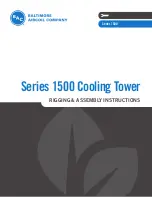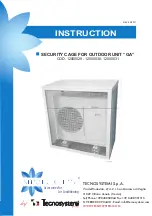
English
9
7. OPTIMUM OPERATION
Observe the following precautions to ensure the
system operates properly.
• Adjust the room temperature properly for a com-
fortable environment. Avoid excessive heating or
cooling.
• Prevent direct sunlight from entering a room dur-
ing cooling operation by using curtains or blinds.
• Ventilate often.
Extended use requires special attention to venti-
lation.
• Do not keep doors and windows opened. If the
doors and windows remain open, air will flow out
of your room causing a decrease in the cooling or
heating effect.
• Never place objects near the air inlet or the air
outlet of the unit. It may cause deterioration in the
effect or stop the operation.
• Turn off the main power supply switch to the unit
when the unit is not used for longer periods of
time. If the switch is on, it uses electricity. Before
restarting the unit, turn on the main power supply
switch 6 hours before operation to protect the unit.
(Refer to the chapter “Maintenance” in the indoor
unit manual.)
• When the display shows “
” (time to clean the
air filter), ask a qualified service person to clean
the filters. (Refer to the chapter “Maintenance” in
the indoor unit manual.)
• Keep the indoor unit and remote control at least
1 m away from televisions, radios, stereos, and
other similar equipment.
Failing to do so may cause static or distorted pic-
tures.
• Do not use other heating devices directly beneath
the indoor unit.
If you do, they might get deformed by the heat.
• It takes time for the room temperature to reach the
set temperature.
We recommend starting the operation in advance
using timer operation.
• Fully use the function of air flow direction adjust.
Cold air gathers on the floor, and warm air gathers
in the ceiling.
Set the air flow direction parallel during cooling or
dry operation, and set it downwards during heat-
ing operation. Do not let the air blow directly to a
person.
• Make sure that the inlet and outlet of the indoor
unit are not clogged.
8. MAINTENANCE
8-1
HANDLING OF HEAT SOURCE WATER
Requests from manufacturer;
• Do not fail to mount a strainer (sold separately as
an accessory) in the inlet pipe for heat source
water intake.
• Do not use any water contaminated by relatively
high level of foreign materials for heat source.
• Carry out the control of water quality without fail.
Otherwise, corrosion of condenser or piping
occurs or germs may be generated.
• For the timing of cleaning and its method, consult
with the dealer you purchased the unit.
Cleaning of the heat-exchanger on the water side
• Water scales, mosses, etc will accumulate on the
heat-exchanger on the water side within an air-
conditioner during use for a long period. Carry out
cleaning at a regular interval. If water scales,
mosses, etc. have accumulated, the cooling and
heating capacity may decline. The safety device
will be repeatedly actuated causing normal oper-
ation to become impossible.
• For use in an area where the water quality is poor,
increase the frequency of cleaning.
Cleaning of strainer
• Clean the strainer in the inlet pipe of heat source
water intake.
8-2
AT THE BEGINNING OF THE SEASON
Check
• Are the inlet and outlet of the indoor unit blocked?
Remove anything blocking them.
• Run the pump and make sure that the water is cir-
culating.
If you operate without water circulating, the unit
may be damaged.
Clean the air filter and exterior.
• After cleaning the air filter, be sure to put it back in
the same position.
See the operation manual included with the
indoor unit for details on how to clean it.
Turn the power on.
• When the power comes on, the characters in the
remote controller display appear.
(To protect the unit, turn the power on at least
6 hours before operating. This makes starting
operation smooth.)
8-3
AT THE END OF THE SEASON
On a clear day, use fan operation for around half a
day to thoroughly dry out the interior of the unit.
• Refer to page 6 for details on fan only operation.
01_EN_3P153897-7L.fm Page 9 Friday, July 11, 2008 1:58 PM
Summary of Contents for VRV-WIII RWEYQ8PY1
Page 3: ...1 4 3 NOT AVAILABLE 2 5 6...
Page 20: ...3P153897 7L EM08A054 0808 HT...






































